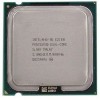Intel E2180 Design Guide - Page 46
Environmental Reliability Testing
 |
UPC - 683728169121
View all Intel E2180 manuals
Add to My Manuals
Save this manual to your list of manuals |
Page 46 highlights
Balanced Technology Extended (BTX) Thermal/Mechanical Design Information Table 5-3. VR Airflow Requirements Item Target Minimum VR bypass airflow for 775_VR_CONFIG_06 processors 2.4 CFM NOTES: 1. This is the recommended airflow rate that should be delivered to the VR when the VR power is at a maximum in order to support the 775_VR_CONFIG_06 processors at TDP power dissipation and the chassis external environment temperature is at 35 ºC. Less airflow is necessary when the VR power is not at a maximum or if the external ambient temperature is less than 35 ºC. 2. This recommended airflow rate is based on the requirements for the Intel® 965 Express Chipset Family. 5.1.5 Altitude The reference TMA will be evaluated at sea level. However, many companies design products that must function reliably at high altitude, typically 1,500 m [5,000 ft] or more. Air-cooled temperature calculations and measurements at sea level must be adjusted to take into account altitude effects like variation in air density and overall heat capacity. This often leads to some degradation in thermal solution performance compared to what is obtained at sea level, with lower fan performance and higher surface temperatures. The system designer needs to account for altitude effects in the overall system thermal design to make sure that the T requirement for the processor C is met at the targeted altitude. 5.1.6 Reference Heatsink Thermal Validation The Intel reference heatsink will be validated within the specific boundary conditions based on the methodology described Section 5.2. Testing is done in a BTX chassis at ambient lab temperature. The test results, for a number of samples, will be reported in terms of a worst-case mean + 3σ value for thermal characterization parameter using real processors (based on the thermal test vehicle correction factors). 5.2 Environmental Reliability Testing 5.2.1 Structural Reliability Testing Structural reliability tests consist of unpackaged, system -level vibration and shock tests of a given thermal solution in the assembled state. The thermal solution should meet the specified thermal performance targets after these tests are conducted; however, the test conditions outlined here may differ from your own system requirements. 46 Thermal and Mechanical Design Guidelines















